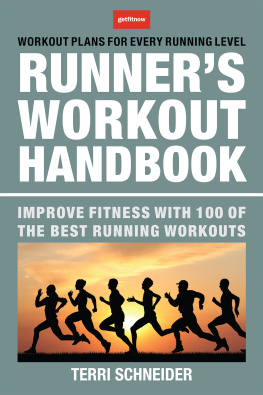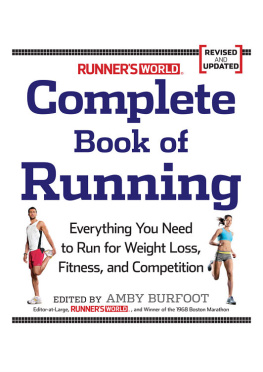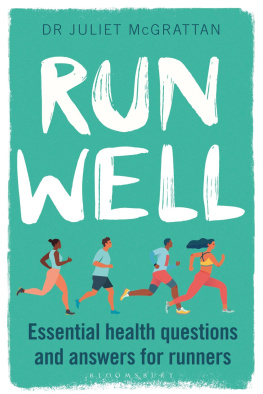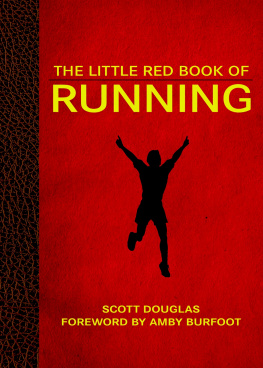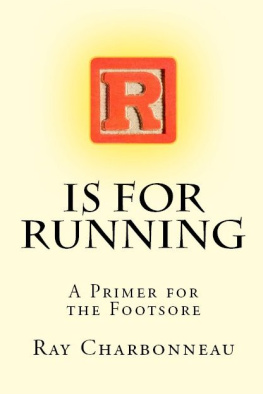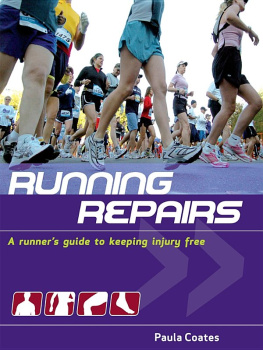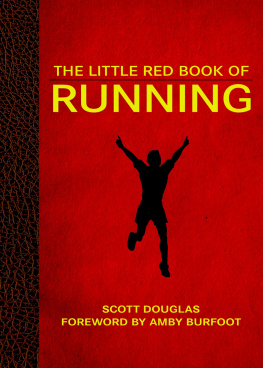ACKNOWLEDGMENTS
Many people helped make this book possible, directly or otherwise. I wish I could name them all here. Instead Ill call out a special few, including Amby Burfoot, my first boss at Runners World, and David Willey, my current one. My editor, Courtney Conroy, who not only tolerated my fartlek jokes but actively encouraged them. Art director Chris Rhoads and illustrator Todd Detwiler, who made this book look better than I ever imagined. Budd Coates, who has coached and cajoled me to every PR Ive ever run. John Mr. Lewis Lewis, who once told an aimless student, Your calling is writing. The late J. I. Rodale, who many decades ago founded a publishing company dedicated to helping people live better, healthier lives, whereyears latera weirdo runner like me could find a niche. And the entire Rodale family, who continue to make Rodale Inc. a special place to work.
I would be remiss if I didnt also thank every person who has ever raced or run alongside me. You didnt know it, but I was taking notes the whole time.
Finally, Id like to acknowledge all of my RunnersWorld colleagues, the nicest and most passionate bunch of people youll ever meet. Being able to work with you every day is a privilege.
Thank you all.
For Sarah, my wife and my best friend. And for Mom and Dad.
CONTENTS
INTRODUCTION
R unning is simple. This is part of its appeal. You dont need a room full of pricey equipment or a squad of teammates in order to run. You dont need to reserve a court or phone in advance for a tee time. Running doesnt even require much skill and, in fact, is instinctualits as old as fight or flight. Nothing could be easier.
Naturally, there are tons of rules.
Not for the act of running itself, of coursenot for running, the verb. The only rules you need to remember for running-the-verb are these:
- Use your legs to move forward (or to avoid moving backward if youre on a treadmill).
- At some point, both feet must be airborne at the same time. (Otherwise, youre walking, shuffling, or lunging. Or skating, if you happen to be on skates.)
- Avoid running into things, such as holes, vehicles, structures, cacti, lampposts, fences, other animals, and large bodies of water.
Nail those rules, and youre in business. You are running.
No, for the purposes of this book were talking about the rules of running, the noun. (More specifically, for those editorially inclined: the gerund.) About the act of running. About the codelargely unspokenthat governs behavior and informs decisions in situations that every runner encounters sooner or later.
) And, of course, this classic
What do I tell a marathoner who is lurching along at mile 20 like a zombie in search of brains? (Answer: Lookin good!) ().
For anyone who laces up a pair of running shoes, such quandaries are inevitable.
Consider The Runners Rule Book a guide for these situationsan instruction manual that, until now, has existed only in bits and pieces, here and there: a few rules in a magazine article; a few more on someones blog; a hundred others floating in the ether, passed down from one generation of runners to another.
Understand that only some of these are rules in the classic do this/dont do that sense. Others are rules only in a very broad, advisory sense. And none of them are rules in the USA Track & Field Competition Rules Book kind of way; you wont find guidelines here on, for example, the type of pistol used to start a USATF-sanctioned road race.
On the other hand, you wont find guidelines in the USATF rule book on passing gas during a group run (). So there you go.
Regardless, I hope you find The Runners Rule Book useful. Just as important, I hope you enjoy it. Because the first rule of running, as far as Im concerned, is this:
Have fun..
MARK REMY
3 RULES FOR USING THE RULES
- Understand why these rules exist. These rules exist to make all of our lives easier. (Yes, yours too.) To make runningand, in a sense, the worldjust a little bit hap- pier, healthier, and less irksome. For everyone.
- Let common sense prevail. If ever you find yourself in a situation where obeying one of the following rules could result in mortal embarrassment; damage to property or reputation; pain, suffering, or loss of life or limb; or a flagrant disregard of community standards, by all means, break the rule. Use your head.
- When in doubt, ask yourself,What would Pre do? And if you dont know who Pre is, you should probably start with Rule No. 1.10.
Of not less than.32 caliber, with powder giving a distinct flash/smoke, in case you were wondering.
A useful grab bag of tips and wisdom on everything from elite etiquette to the farmers blow, tan lines to training plans. And the perils of asking strangers for body lube.
Y ou thought I was kidding when I called this the first rule of running? No way. Im serious about having fun. And before you smirk and flip the page, please take this first rule to heart. It is primary and vital, and without it, no other rule in this book is worth beans. No other fact is so fundamental to running or so very easy to forget: Done properly, running is fun.
In fact, even when you do it improperly, running is still pretty fun (just like another animal impulse that we could mention, but wont). It is inherently, liberatingly fun. There is a fundamental joy in movement, in forward motion.
If you doubt this, just spend a few minutes watching a child or even a dog in any wide, open space. Their glee is instinctual and undeniable. I believe it was Aristotle who once said, Tramps like us, baby, we were born to run. In any case, remember this one primary rule, and youre halfway there.
Running is fun. Indulge this instinct. Enjoy it. After all, there arent many animal impulses that we can act on in public without getting arrested.
RULE 1.2
EXPAND YOUR DEFINITION OF FUN
T his is a corollary to Rule 1.1. As a runner, your definition of funwhich previously might have included such activities as visiting water parks, watching screwball comedies on DVD, and scrapbookingmust be well, lets call it broadened.
- For runners, fun might include:
- Waking up at 5:30 a.m. to run 10 miles
- Running in blistering heat
- Running in the rain
- Running in 400-meter circles
- Feeling as if your lungs are about to explode
- Paying a race director good money for the privilege of turning your own toes black and blue
- Any combination of the above
I mpatience is the runners single biggest bugbear. This is true for just about every aspect of running. Whether youre talking about training (trying to do too much too soon), racing (going out too fast), shoes (buying the first pair you see), or even nutrition (opting for a Pop-Tart over a bowl of steel-cut oats), expediency almost always leads to the poorer choice. So take a deep breath. Consider your options. Make smart choices.
Patience pays off.
R un long enough and youll wind up ruining a toenail or two. Its a cost of doing business as a runner.
Whether its because your shoes are too big or too small or because youve just finished a run or race with lots of toe-punishing downhills or simply because the toenail gods happen to be in a foul mood, someday you will peel off your socks and see black where before there was pink.



